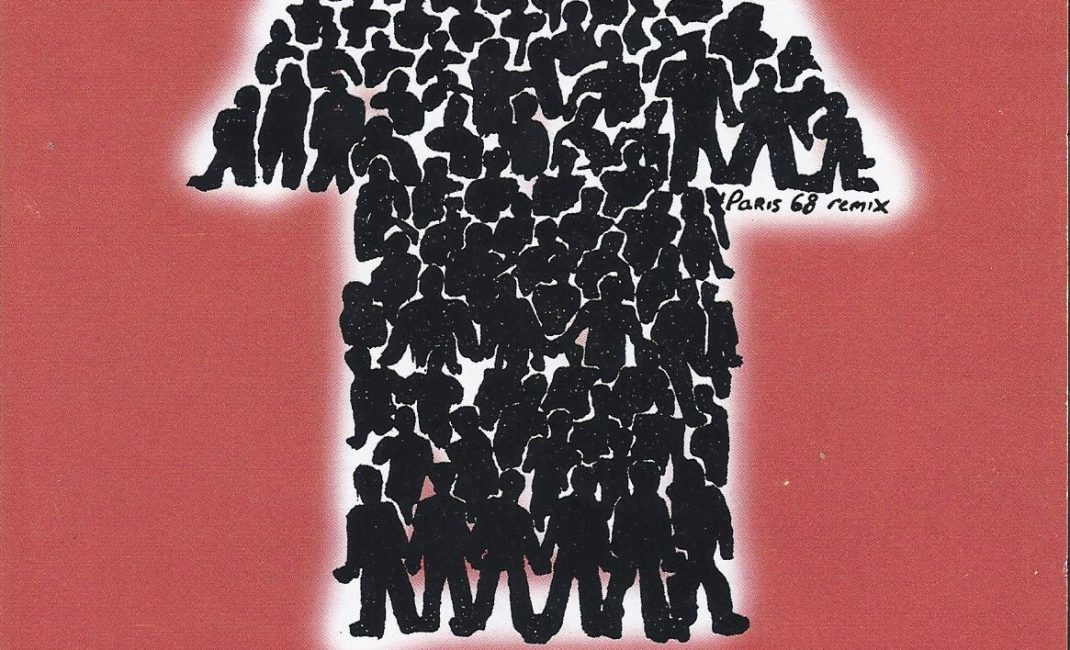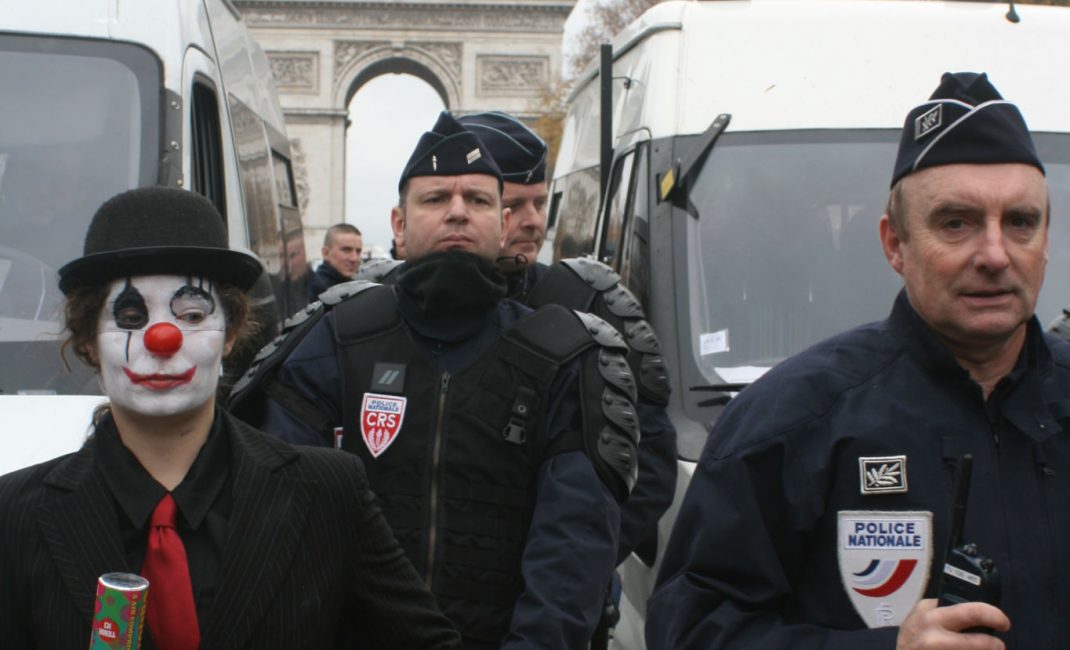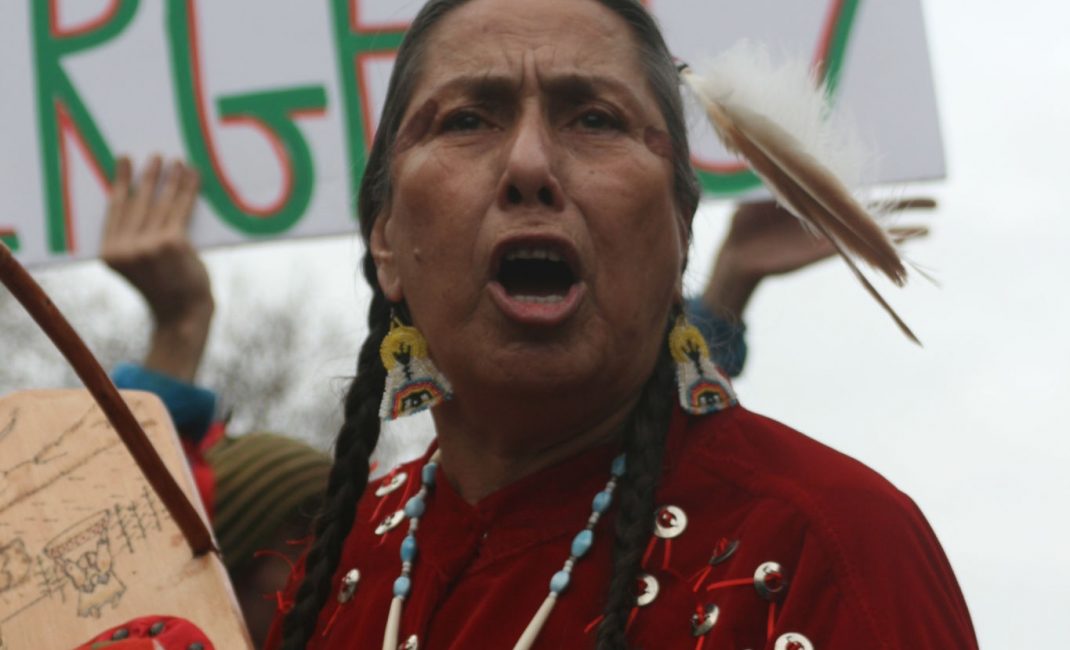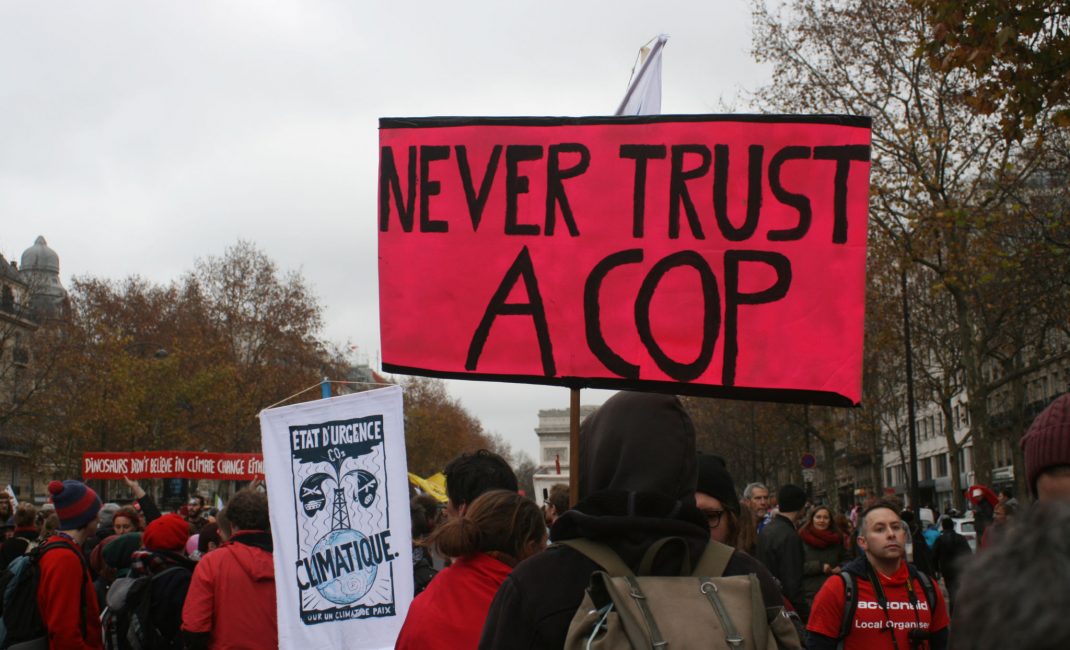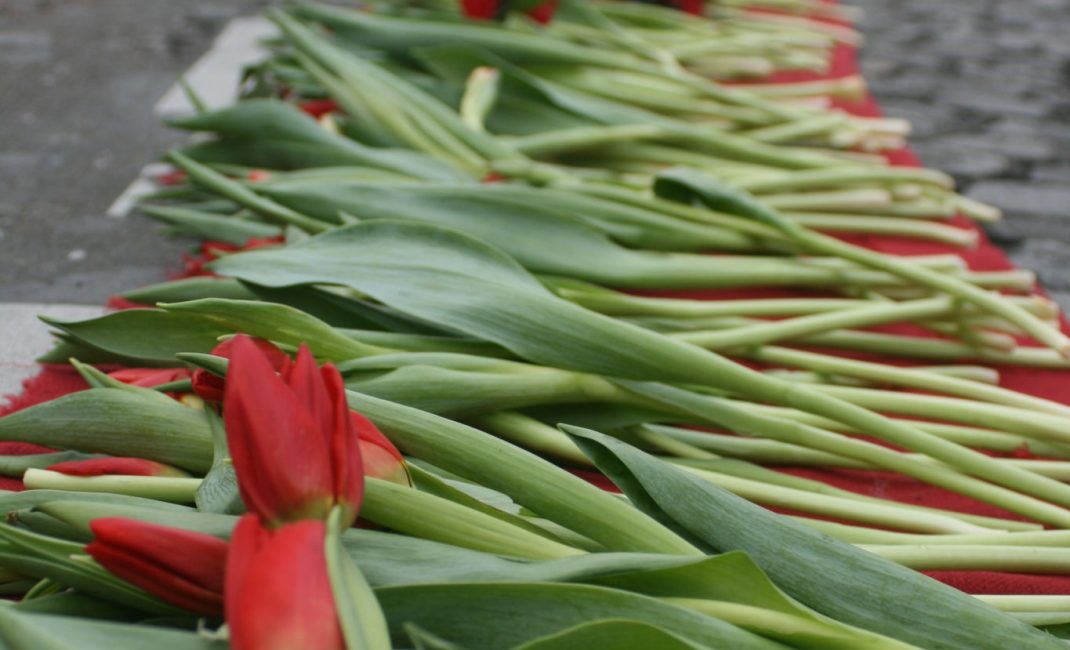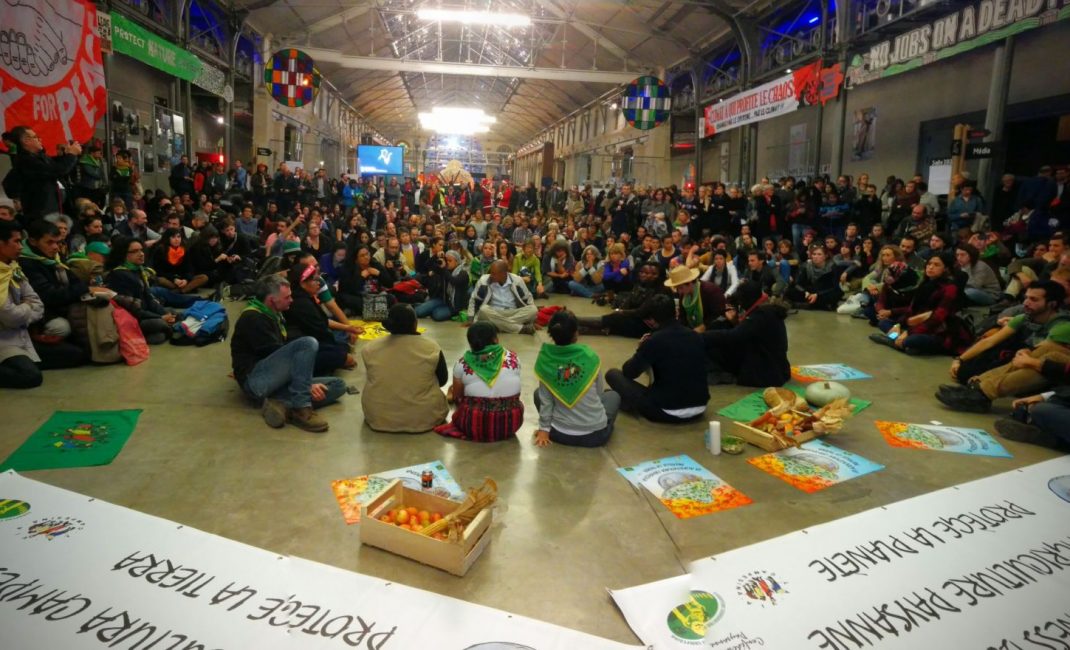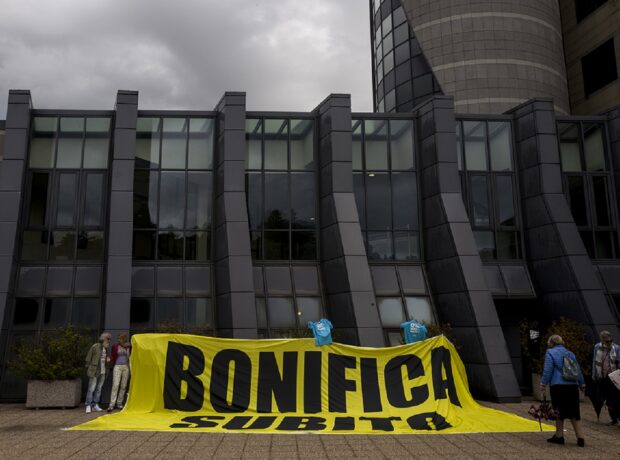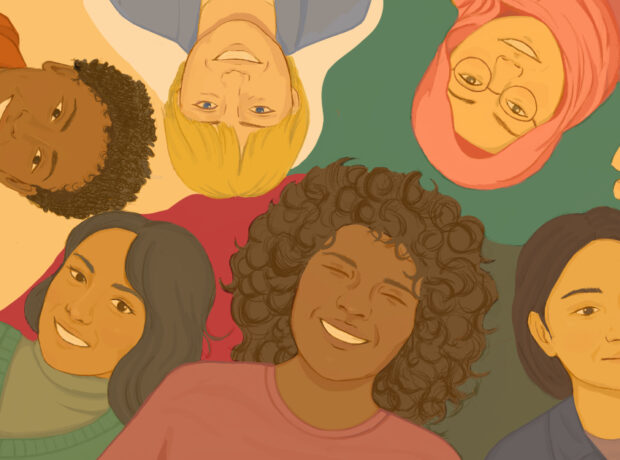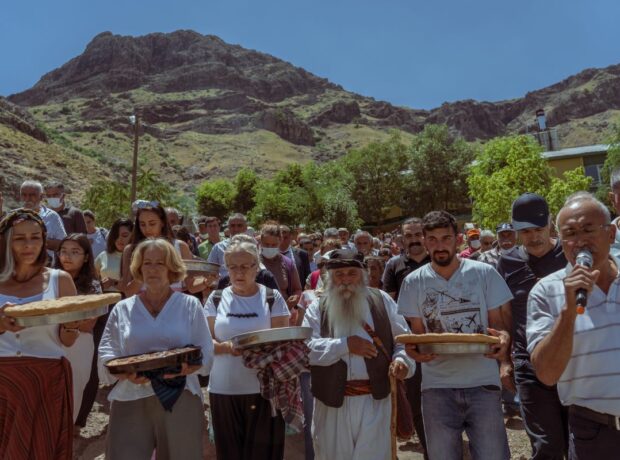Adam Weymouth joined the protestors at the UN climate change conference in Paris in December 2015. When he arrived, he found a state of emergency and a myriad of activists unsure of how best to respond. By the time he left, his despair at the politics inside the conference hall was tempered by hope at the alliances activists had formed outside, and what they might do next.
A State of Emergency
When I arrived in Paris in early December, there was little evident in the bustle of Christmas markets and cafés that 130 people had been murdered two and a half weeks before, and that the country was under a state of emergency.
At Place de La République the candles were still burning, a sea of flowers and defiant slogans beneath the statue of Marianne, but at La Bonne Bière, where five people were shot dead, the walls had been repainted and the terraces were full. In the 19th arrondissement, where the Zone D’Action Climat (ZAC) had convened, there were armed police outside the Jewish schools, but they had been there since the Charlie Hebdo shootings in January and by now they were coming to be seen as the new normal.
“For about three or four days anything could reduce you to tears,” said Alexis Rowell, coordinator for the English speaking volunteers at the ZAC, the space set up for activists to congregate during the second week of the conference. “Any loud noise made you jump, or drop to the ground.” He runs through a list of friends who were personally affected by the attacks. “It’s just astonishing how many people of our ilk were caught up in it,” he says. “What we call in French ‘les bobos’. Progressive, probably left wing, right on, living in the 11th, 10th 19th, that sort of area. Vaguely intellectual, with a social conscience.”
Åsa Romson, the Swedish deputy prime minister and minister for the environment, was much criticised for her tweet in response to the attacks – “The very serious events in Paris right now can impede the Climate Change Conference in December” – but almost everyone organising around the negotiations had been thinking similar thoughts, especially when a ban was placed on all public demonstrations.
Alexis Rowell believed the government was “taking advantage” of the situation. “Football matches, no problem,” he told me. “Christmas markets, trade fairs, all sorts of gatherings are not prohibited whatsoever. But climate protests are.” By the end of November, 24 climate activists were under house arrest as the police exercised their new powers, and there they would remain until the end of the conference. On the first day of the negotiations, dawn rose over ten thousand pairs of shoes in the Place de La République, symbolising those who had not been allowed to march.
Naomi Klein, the movement’s go-to spokeswomen since the publication of her This Changes Everything last year, denounced the ban as “disturbing on many levels.” The citizen-led alternatives and demonstrations are integral to the talks, she wrote in The Guardian, and if the French government couldn’t facilitate this component of the conference then none of the summit should be given the go-ahead. It was a fine line. Not protesting was being drawn by many as somehow part and parcel of showing respect for the dead. Yet for many others, the fact that their demonstrations were not going to be state-sanctioned was not going to put them off.
A Newfound Diversity
Neither the terrorist threat, nor the ban on protest, seemed to be having much effect on those turning up on the outside of the conference walls. By the Thursday evening of the second week there were four thousand people at the evening’s General Assembly in the ZAC, drawn from all across the globe, and Alexis was fighting to keep the aisles clear. The direct action trainings overflowed out of the room: there were more people in attendance than the organisers had planned for, even before the attacks happened.
The COPs are as important in activist calendars as they are for delegates, and as much as the conference centre provides a focal point for protest, the gatherings outside the summit are equally crucial, and are at their most powerful in the connections they facilitate. Work carried out during the year in isolation draws sustenance and inspiration through these networks, solidarity is stoked. The Grass Roots Global Justice Alliance took a delegation to Paris called ‘It Takes Roots to Weather the Storm’, bringing together not only groups that rarely hold the same banner, but that until recently would not have seen their place at a conference concerned with climate change. Such diverse activists as those from Iraq Veterans Against the War, the Indigenous Environmental Network, the Vermont Workers’ Center, the Asian Pacific Environmental Network and the World March of Women. Or Via Campesina, representing 200 million peasant farmers worldwide: I crashed their party one night, and found myself dancing side by side with Quechua farmers and workers at Organic Lea, French paysannes and Gambian smallholders.
Such diversity wasn’t nearly as apparent at the talks in Copenhagen six years ago. It owes much to the growing prominence of climate justice, a concept that many within civil society paid little more than lip service to until recently. At a demonstration outside the main conference centre, Le Bourget, I ran into members of the Historical Black Colleges and Universities (HBCU), representing 22 different educational institutions around the US. The demonstration had been organised by Black Lives Matter, to highlight the health impacts of fracking sites on local communities. HBCU had come to Paris to advocate for better climate policy, with the intention of emphasising how race needed a more significant role in the debate. “A lot of the talks, they lack equity. They lack the idea of environmental justice,” Adria Peterkin, 20, said to me. “You have to talk about refugees, what can we do about them, you have to talk about so many different aspects. I feel like that’s not included in the conversation. The talks are only about how to lower the actual emissions, but it’s about so much more than that.”
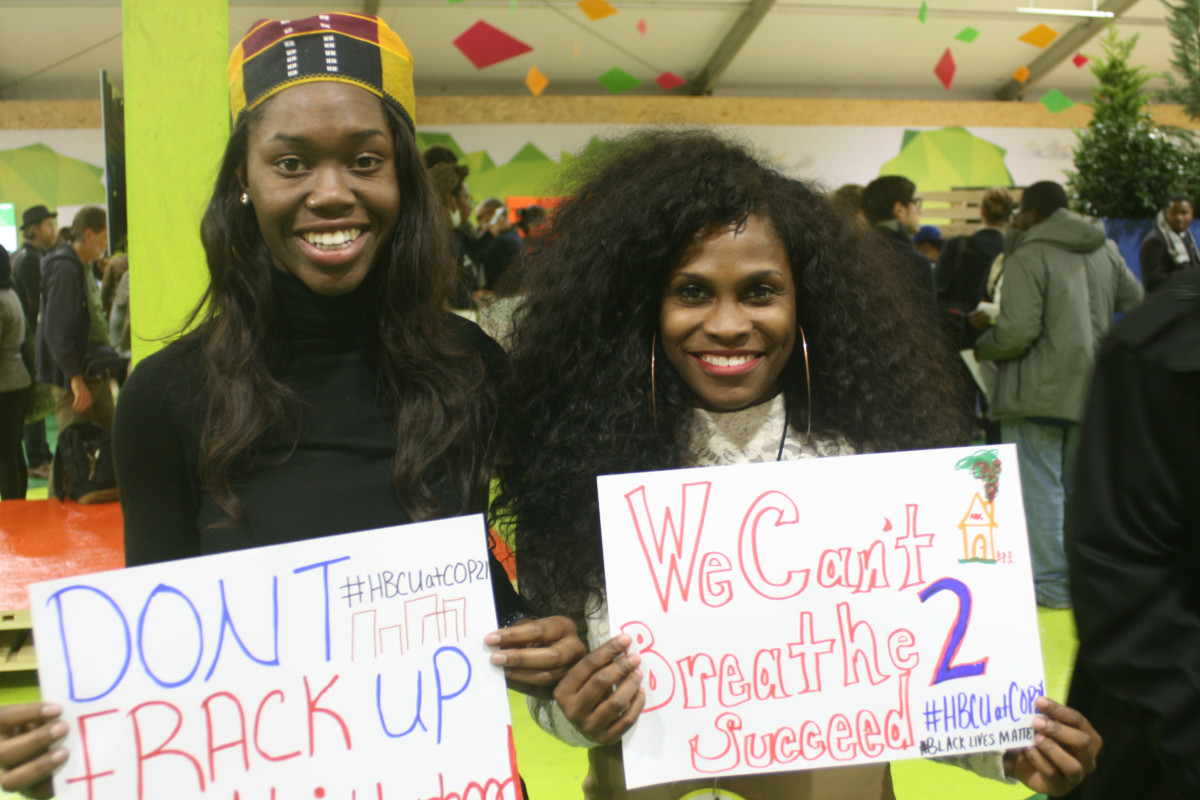
Adria Peterkin and Jenise Young, representing Historical Black Colleges and Universities.
“The conference isn’t really representative of a lot of the people who we would consider frontline communities,” agreed Jenise Young, 34. “People who live adjacent to these power plants, who don’t have voices. People who are marginalised, who have an historical trend and pattern of more than fifty, sixty years of living in these communities. I live in Houston Texas, and you can only imagine the families that have had generations around these polluting facilities.”
I asked her how she thought the conference might pan out. “I think it may be positive for some, but not for all,” she said.
The idea that the so-called solutions to climate change will benefit only a section of the global population goes to the heart of what is meant by climate justice, and means that a critique of capitalism, who it favours and who it marginalises, is now explicit in much of the discourse around the COP. At the opening of the summit Evo Morales, the Bolivian president, called capitalism “the formula that has destroyed our species.” But this is not the majority held view within the UN. Such is the dominant model of our times that Kevin Anderson of the Tyndall Research Institute has said that the UN process is more inclined to try and shoehorn the science to fit the current paradigm, rather than the other way around. Speaking to Democracy Now during the talks, he said “We fine tune our analysis so it fits within the political and economic framing of society. We don’t really say that our science now asks fundamental questions about this idea of economic growth. We’re very reluctant to say that.”
A critique of capitalism, who it favours and who it marginalises, is now explicit in much of COP discourse
On a damp morning, Iraq Veterans Against the War gathered with other members of It Takes Roots between the Peace Wall and the Ecole Militaire for a demonstration that highlighted the strength and diversity of their coalition. “I’ve seen pollution from billions of bullet casings, generators and diesel engines, depleted uranium and white phosphorus, causing cancer, birth defects and contaminating the water,” Derek Matthews shouted through a megaphone, a US Marine Corps veteran with deployments to both Iraq and Afghanistan. “How can we solve climate change without challenging the biggest polluters and destroyers of this earth? We must challenge them. Extractive economies and climate change are only possible when protected by guns and militarism.”
Shawna Foster served in the US National Guard as a Nuclear Biological Chemical Weapons Specialist. “You can’t go over and bomb another country if you think that they’re the same culture as yours,” she said when I spoke to her later. “Just like you can’t go over and take other peoples’ resources if you respect their own inherent worth and dignity. Being anti-racist in our approach starts to undo climate change, and it starts to undo the military.”
“But it’s not even a climate change solution, it isn’t even like a let’s save the polar bears kind of solution,” she continued. “It’s a just transition. Recognising people like veterans, who have no economic opportunity, they need a job that isn’t killing people. They need a job that isn’t defending war profiteering. They need a job that isn’t about oil extraction. That is about building an economy for people and the planet.” A 2008 report by Oil Change International found that projected U.S. spending on the Iraq war would have covered the global investment required in renewable energy up until 2030 to halt global warming trends. “Imagine if we treated climate change like we do terrorism,” said Foster.
A Turning-Point?
Being in Paris just weeks after the attacks, the links between climate change and war were being made more explicitly than might otherwise have been. As the COP went into its second week, veterans arrived at Downing Street to hand back their medals in disgust at Parliament’s vote to launch airstrikes on Syria.
“We’ve got to take a longer term view of this,” said Ben Griffin, head of Veterans for Peace. “Every time we attack somewhere, every time we bomb somewhere and kill people, we create an enemy.” Tony Blair had alluded to this in an interview with CNN in October, when he acknowledged “elements of truth” to claims that the 2003 Iraq invasion had led to the rise of ISIS. That war is now seen by many as having been about securing oil and gas reserves in the region, and there is growing suggestion that the alliances forming around Syria could be about the very same. Investigative journalist Nafeez Ahmed has chronicled how two competing plans for a gas pipeline, exporting either Iranian or Qatari oil across Syria to Europe, have been instrumental in how coalitions have developed around the Syrian war, and why Turkey and has not been held to account for their tacit support of ISIS. (Research carried out by Columbia University has found that the Turkish government has provided “military cooperation, weapons, logistical support, financial assistance, and medical services” to ISIS.)
Couple this with a 2015 study that suggests that a severe drought in Syria between 2006 and 2010, a drought made much more likely thanks to a changing climate, was an aggravating factor in destabilising the country before the outbreak of the civil war, and a picture begins to emerge of the deep connections between war, resources and climate change. Of course, the drought is by no means the cause of the atrocities in Syria, or what has perpetuated them for so long, but the Intergovernmental Panel on Climate Change (IPCC) has found with “medium confidence” that a changing climate can have indirect effects on exacerbating the risk of violent conflict “by amplifying poverty and economic shocks.”
A changing climate exacerbates the risk of violent conflict
It is a depressing picture, but perhaps not entirely so. Many people I spoke to, who have followed the negotiations for years since their conception at the Rio Earth Summit in 1992, believe a change is in the air. This year, for the first time ever, global emissions have fallen during a period of economic growth. The decline has been attributed to China’s slowing economy and the subsequent dropping off in their consumption of coal, and whilst the fall is expected to be an anomaly, not predicted to last, it feels symbolic. The hegemony that the fossil fuel companies have enjoyed for so long appears to be having a wobble. In 2015 the Keystone XL pipeline project was shut down, and oil companies retired from Alaskan waters. ExxonMobil and Peabody Energy (the world’s biggest private coal company) are under investigation for misleading the public on climate change by funding groups that deny climate change and spreading disinformation about the science. Adam Ramsay, reporting at COP 21 for OpenDemocracy, wrote that oil companies “seemed to feel very strongly that they have lost control of the narrative.”
One of the alternative narratives jostling for position is divestment, persuading investors to take their money out of fossil fuels and to invest in a cleaner portfolio. It was a campaign much in evidence in Paris, gaining traction within the conference halls as much as on the outside. A 2013 paper by the University of Oxford suggested that its main power lay in making a pariah of the industry, and that “any direct impacts pale in comparison.” But two years on and the campaign is shifting from stigmatising an industry into the realm of mainstream economic debate.
If we are to keep “well below” two degrees of warming, as was agreed in Paris, then more than four-fifths of known fossil fuel reserves will have to be left below ground. Yet with those reserves already included in companies’ portfolios, there is a high risk of them becoming stranded assets, and investors are beginning to take note. In September, Mark Carney, Governor of the Bank of England, warned of “potentially huge” losses if action on climate change prevented those reserves from being extracted. In November the world’s biggest asset manager, BlackRock, stated that “climate change has arrived as an investment issue.” 350.org launched the divestment campaign in 2013. They announced at the start of COP21 that more than 500 institutions, representing more than $3.4 trillion in assets, have now made some form of divestment commitment. That included the Rockefeller Brothers Fund, the World Council of Churches, the London School of Economics, Axa, and entire cities such as Oslo and Melbourne.
Concurrently, investment in clean energy alternatives is burgeoning. The Breakthrough Energy Coalition, announced in Paris, is made up of more than 25 investors, including Bill Gates, Mark Zuckerberg, Richard Branson and George Soros, and aims to kickstart a “new economic revolution,” mostly by ploughing money into clean energy companies in their early stages across a range of sectors. At the same time, Mission Innovation, comprised of 21 governments, including Britain, pledged to double the amount of public money that is being used to fund research into clean energy. Investors need confidence, and are moved by markets, not ideology. But as both science and policy send increasing signals that fossil fuels must be phased out, markets and ideology could be beginning to align.
A Very Different Kind of Protest
At sunrise on the last day of the COP, members of the Indigenous Environmental Network gathered in front of Notre Dame for a prayer ceremony. Moved on by the police, they reconvened on the Pont des Arts. They were representing First Nations’ people from across the globe, Saami, Navajo, Maori, continents and cultures apart, but bound by a common message.
Speaking at an event several days previously, Chief Raoni of the Kayapo People in Brazil had told the assembled media that: “The indigenous people have more or less the same threats and the same problems throughout the world.” As with the wider climate justice movement, it was the finding and voicing of these connections that was forming the sort of broad alliances that gave strength both to their individual causes and to their mutual goals. In traditional costume, their music and story a welcome break from the familiar rote of slogans and campaign speeches, and speaking to something that many of us feel we have on some level lost, they found themselves at the front of marches and as leading items on the news. The week before many of them had taken to the Seine in canoes and kayaks and made headlines around the world.
“In the United States they are killing our indigenous people in the name of taking fossil fuels out of the ground,” said Kandi Mossett of the Mandan, Hidatsa and Arikara nations, North Dakota. “Here at the COP 21 they are proposing false solutions to the climate crisis. They are proposing a commodification of the sacred. They want to put a price on the air we breathe…Our babies are dying. They can’t even breathe the air. We need to fight back. We are the frontline. We are the red line. And we will protect our blood lines.”
“They want to put a price on the air we breathe”
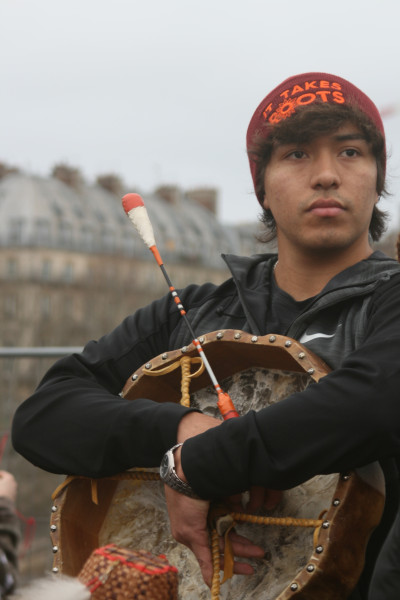
Matthew Jefferson of the Lummi Nation.
Over the previous two weeks of talks they had seen the references to indigenous rights in the text shuffled around in a succession of drafts, until ultimately they were relegated to only the paragraphs that were not legally binding. This was in part thanks to pressure by the UK, the EU, Norway and the US, who feared the liability that could follow legal recognition. As is so often the way in the UN, pulling a big enough punch will get you what you ask for. That morning, with the grey sky lightening, they drummed and sang, and they spoke about their homes.
“I’ve been a hunter and fisherman since I was young, and I’m not old yet, and I’ve seen changes,” said Matthew Jefferson, 20, of the Lummi Nation, western Washington. “We’re people of the water. If the water temperature changes, or the water level rises, we feel it in our culture. We know we have to change something to keep our culture safe.”
“Climate change isn’t a strong enough of a word,” agreed his brother Richard. “Because it’s changing our whole way of life. It’s bigger than just the temperature. We’ve already survived one cultural genocide. It’s tough not to stand up for it again.”
“We come here with a blessing for Paris,” said Casey Camp-Horinek of the Ponca Nation. “We know what happened on November 13th, and I can tell you that we indigenous people know how that feels. To have someone kill the innocent ones. To have someone not care about life itself.”
Indigenous rights were relegated to only the paragraphs that were not legally binding
We left the Pont des Arts and made for the Metro. The final demonstration was scheduled for midday, and it seemed likely that the police would start closing down the nearby subway stations before that. As we neared the Arc de Triomphe, the trains began to fill with more and more people who didn’t seem to be there for one of the last big shopping days before Christmas. In my carriage there were the Saami and the Maori, a Franciscan priest, some members of the Rebel Clown Army, Friends of the Earth Cambridge and a man dressed as a sunflower. No one said anything, but there were furtive glances, the tension of shared purpose.
The protest generated by the summit is as diverse as the problems that it seeks to address. The previous two weeks had seen the ‘It Takes Roots’ delegation marching outside the detention centre at Vincennes in solidarity with the migrants inside. In the Louvre, Art Not Oil walked ‘oil’ across the marble atrium in protest of fossil fuel companies sponsoring of museums and art galleries. Via Campesina gathered outside of the headquarters of the food multinational Danone to decry their false solutions to climate change and the impact upon peasant farmers. Representatives of indigenous communities massed outside of Total’s headquarters to protest their involvement in the Canadian tar sands. Protestors crashed the Grand Palais, and replaced billboards at bus-stops across the city, denouncing corporate solutions to climate change. Activists picketed the premiere of Marc Morano’s Climate Hustle, and a gathering of the Heartland Institute, sponsors of much of the climate denialist movement. Inside Le Bourget, civil society organisations and occasionally delegates protested the terms of the text and the continual lack of ambition. There were youth groups, faith groups, trade unions, business leaders. Pilgrims walked from London and Rome, one man ran from the North Pole and another cycled from the South. Their reasons were often deeply personal, multifarious. Much of it seemed to be captured in the slogan that was fly-postered and spray-painted all over Paris: Nous sommes la nature qui se défend – We are nature defending itself.
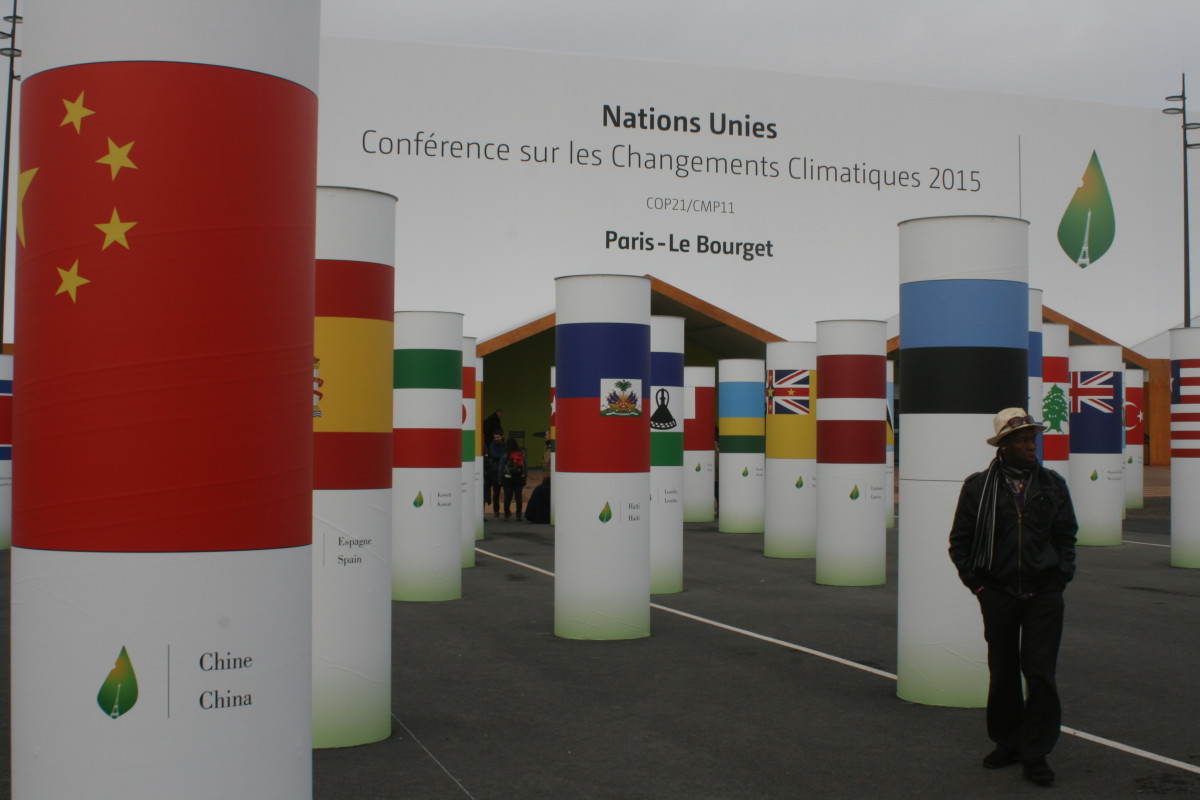
The entrance to Le Bourget.
Activists stress, in the well-worn phrase, a diversity of tactics, but that frequently results in an inability to see eye to eye, and the splintering of a movement. The Coalition Climate 21 convened more than a year before the Paris talks with the aim of finding common purpose, bringing together over 130 grassroots groups and NGOs from across the spectrum. That they collectively agreed that the final action of the conference should have elements of civil disobedience was “unprecedented,” according to Emma Biermann, European Trainings Coordinator at 350.org. The plan was to encircle the entire conference centre at Le Bourget, activists using their bodies to symbolise the non-negotiable lines that the UN must not cross. And then November 13th happened, and everything was different. “The legal situation changed, the political situation changed, the emotional situation changed,” says Biermann. “For everyone.”
“Climate change is a real existential threat. And we are not mobilising with the same urgency”
Protest, defined as “more than two people sharing a political message,” had been banned under the State of Emergency. Consequently what constituted civil disobedience had very much changed as well. To choose to defy the law in ordinary times was one thing, but now the stakes felt higher. To some, the risks didn’t seem worth it; to some, it seemed puerile to be defying the police to protest something as abstract as the climate when what was needed was solidarity with the authorities to guard against a common enemy. For others, that was irrelevant. Yes, it was bad timing, but bad timing only seemed set to become more frequent in an increasingly globalised world. And for others, it was a time to question priorities. As Derek Matthews of Iraq Veterans Against the War said to me: “We have securitised our entire realm, saying that we need bigger military complexes, bigger surveillance industries, in order to protect ourselves from this existential threat, which is extremism…But climate change is a real existential threat. And we are not mobilising with the same urgency.”

Derek Matthews of Iraq Veterans Against the War.
An action carefully constructed over the course of a year had to be reworked in two weeks. Planned against the background of very personal trauma that many of the organisers were going through, it needed to fit the tone of both defiance and grieving that Paris was still feeling. Many of those coming to Paris would be taking direct action for the first time, and the Coalition was very conscious of what risks it could ask them to take, with little way of predicting what the police response might be. The decision to move the planned action away from Le Bourget was taken partly because the surrounding commune had a high Muslim population, and organisers felt uncomfortable about bringing a heightened police presence into a community that was already being disproportionally targeted. The new location chosen was the Avenue de la Grande Armée, one of Haussmann’s vast boulevards that slice through the north-east of the city, better known for protests by the right than by the left. Where, in 2013, 1.4 million turned out in defiance of gay marriage.
And then, on the evening before the action, the authorities gave the go ahead for the demonstration. Presumably they had realised, with the numbers that had persisted in turning up to Paris to take part, that they had little hope of preventing it. At noon on Saturday 12th December, as the negotiations hauled themselves into their final stages, more than 15,000 people walked onto the Avenue and unfurled vast bolts of cloth to symbolise the red lines that must not be crossed, where the people would not back down. Red tulips were laid to honour the victims of climate change. There were the familiar tropes, the polar bear costumes and brass band renditions of Bella Ciao, and there were nods to May ’68, in the vast inflatable cobblestones hefted above the heads of the crowds, and in the screen-prints from the ateliers that had reworked some of the old images.
The riot police blocked off both ends of the boulevard. People danced and chanted, stood for photographs, vaguely wondered what to do at something that wasn’t quite a march and wasn’t quite an action. It was important to come together, to enable a show of strength and celebration between the many groups that had been drawn together by the summit. Biermann had spoken to me of the hunger she had seen in all those turning up to Paris to take action, and certainly it demonstrated that. But, hastily put together and in an arbitrary part of Paris, it was a piece of theatre that felt as if it was lacking in real purpose or cohesion. With the police giving the okay at the final hour, it didn’t even have the merit of being disobedient.
At two o’clock, the designated time, the riot police began to move in, and fifteen thousand people calmly dispersed. It was the one of most peaceful, cooperative demonstrations I have ever been a part of. We all filed down to the Eiffel Tower, beneath its arches and down the Champ de Mars. Rumours were spreading that a deal had been signed. As we waited for the first of the speakers on the temporary stage outside the Ecole Militaire, we tried to find out details. The media were rushing to file their copy, and it was already being hailed as “historic.”
Despair and Hope
Six years before, I had been stood in a similar crowd in Copenhagen when news filtered through of the absolute disaster that was the culmination of that summit. In spite of some last minute backroom dealing by the United States and China, and the announcement of an accord, no one had been fooled. It was embarrassing, and it was widely understood that such a fiasco would not be tolerated again.
Whatever came out of Paris, it was going to be spun in such a way that the leaders could weather the storm. Smiling photos of delegates were splashed across all two of the UK papers that chose to give the deal front page treatment (and a small column in The Times). Much of the media was euphoric in their headlines. Politicians made bold statements. Delegates grinned for selfies. “A huge step forward in securing the future of the planet,” said David Cameron. “Victory!” announced Avaaz. “World leaders at the UN climate talks have just set a landmark goal that can save everything we love!”
Others were not so complimentary. Grassroots groups lined up one after the other to denounce the terms of the text. James Hansen, the NASA scientist who first brought climate change to the world’s attention when he testified before Congress in 1988, called the Paris Agreement “bullshit.” Naomi Klein told the assembled crowd on the Champ de Mars that their so-called leaders had shown themselves willing “to set our world on fire.” Yes, 195 countries had committed to maintaining temperatures “well below 2C,” but to paraphrase the old joke, if you want to get there, I wouldn’t start from here.
Most analyses show that a target of 1.5C is nigh on impossible without technologies that would remove carbon from the atmosphere, technologies which do not yet exist. Even two degrees looks delusional, based on our current form. Before the conference, countries were invited to submit Intended Nationally Determined Contributions (INDCs) to the UN, outlining their plans to reduce emissions over the coming decade or so. These contributions are not legally enforceable, and taken together, commit the planet to somewhere between 2.7C and 3.9C of warming, close to twice what has been deemed acceptable even at the more generous end of the spectrum. The text acknowledges this, and countries are bound to regularly update their commitments, making each more ambitious than the last: a stocktake of the overall situation will be made every five years. Yet the language is all about “inviting” countries to make long-term low-emissions strategies and “encouraging” them towards stricter targets: it feels more like a motivational speech than a document designed to maintain human civilisation.
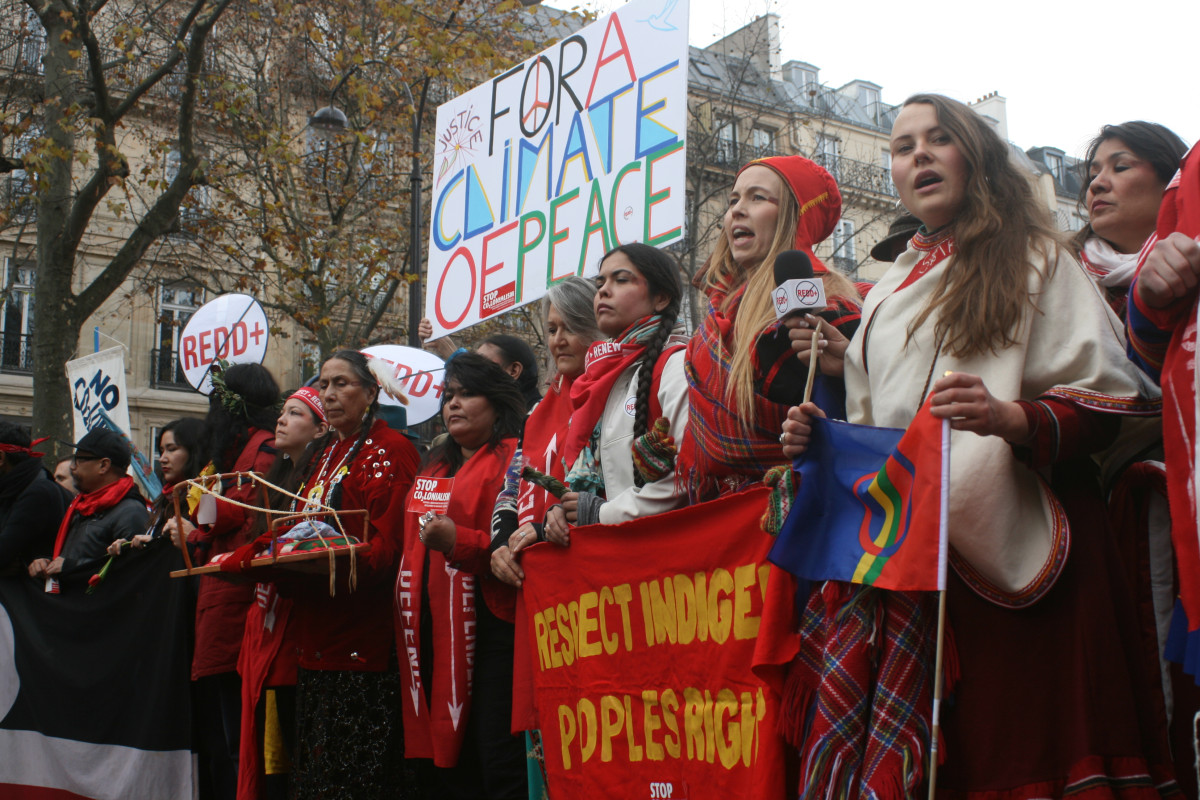
Members of the Indigenous Environmental Network at the final demonstration.
Human rights and indigenous rights have been ignored. Fossil fuels are not once mentioned. There have been unacceptable fudges on countries taking responsibility for historic emissions, and for helping the least developed countries to adapt to both future and present effects of climate change. For the first time, emissions by the military are not automatically exempt, but aviation and shipping are still not included: no one country takes responsibility for them and they are omitted from the text. So when politicians tell us that airport expansion does not contradict our climate ambitions, they are not lying (an announcement on Heathrow’s third runway, expected during the summit, was postponed). They are, perhaps, misusing the notion of ambition.
Aviation and shipping [emissions] are omitted from the text
There were plenty of bold words spoken in Paris. At the opening of the conference, at the largest gathering of world leaders ever assembled, one head of state after another stood behind a podium and strove to outdo each other in pledging their green credentials. “The greatest danger is not that we aim too high and that we miss. The greatest danger is that we aim too low and hit it,” said Hollande. “Climate change has become one of the gravest challenges that humanity is facing,” said Putin. “We know the truth, that many nations have contributed little to climate change but will be the first to feel its most destructive effects. For some island nations, climate change is a threat to their very existence,” said Obama. “What I’m saying is that instead of making excuses tomorrow to our children and grandchildren, we should be taking action against climate change today,” said Cameron. He then went home, and, in the week following the conference, the Conservatives pushed through 65% cuts to subsidies for solar panels on homes and MPs voted to give fracking the go ahead beneath national parks.
It is actions that are needed, not words. But for now, at least, we have some words, and the words are something that can be built upon by campaigners. “Well below 2C” might seem pie in the sky, but there has been official agreement that this is worth attaining, an acknowledgment that the interests of the poor, of the small island states, are at risk, and are as important as the economies of the rich. There has been official agreement that current commitments are not adequate. ‘Loss and damage’ – dealing with the effects of climate change already upon us – has a place in the text, and despite fudging it to avoid any legal ramifications for the countries which are most responsible for emissions, it is an acknowledgment that climate change is already destroying lives. And although fossil fuels were not mentioned, Shell, BP, Total, Eni, and other major producers all saw their shares fall after Paris.
Harjeet Singh of ActionAid called the agreement “an important hook on which people can hang their demands.” And that is perhaps the most significant result of all. Copenhagen was catastrophic, not only in its failure to achieve an agreement but because of its impact on the climate movement. Most mainstream NGOs had billed it as the make or break conference when the world had to deliver, and almost everyone bought into the narrative. There was a collective suspension of disbelief akin to watching a World Cup Final, the fervent passion that if you only shouted loud enough you could influence the outcome. It was rare to find anyone who believed the UN capable of coming up with the sort of ambitious agreement that was needed, but that did nothing to stop everyone buying into the illusion, and then suffering the fallout when the outcome was so inevitably dire.
Many who took to the streets for the first time when they marched against the Iraq War in 2003 never returned to another demo when they saw how easily their governments could dismiss them. Similarly, many who had been led to believe that getting involved in Copenhagen would help fix the planet quit the climate movement for good. “Post Copenhagen we lost so many people,” Biermann told me. “[We said] we can’t do this to our movement again….And given our circumstances, particularly the circumstances of the attacks, we did a bloody good job. I think we can be proud of what happened.” Regardless of what the UN produced, Paris was to be about building a movement, another step along the way, stoking the hunger for the fight that was to follow. Even as the dust was settling on the conference, a coalition of groups, from Greenpeace International to WoMin African Gender and Extractives Alliance, from Asian Peoples Movement on Debt and Development to Oil Watch, announced plans “to shut down the world’s most dangerous fossil fuel projects and support the most ambitious climate solutions.” Under the slogan Break Free 2016, this May they will be targeting projects on every continent, from Canada to Brazil, from Spain to Indonesia. This is the sort of momentum that is needed.
Britain’s weather has changed. Climate change is the new normal
This winter, Britain had its hottest November night on record, followed by its hottest December, and its wettest. 2014 was the warmest year ever recorded, until surpassed by 2015. A recent forecast issued by the MET office predicts that 2016 will be hotter still. Records are toppling everywhere. “The flood defences were designed for a once in a hundred-years event,” said the mayor of Keswick in December. “We were sort of surprised we got one so soon.” It was the second they had had in six years. Britain’s weather has changed. Climate change is the new normal. It is up to us how we react to it. If Paris is a springboard for growing global protest, for holding leaders to account, for turning words into actions, for a realisation of common values, only then can we honestly label it as historic.
“It’s not going to get us where we need to be, but it’s a start,” said Matthew Jefferson of the Lummi Nation, speaking to me as the agreement was made. “The solution isn’t going to come from the negotiators, but it’s going to come from us. The youth. All those people that are in there negotiating, they’ve had their future. We are fighting for our future. They have to listen to us. Because we’re the ones that are going to be left behind. Not them.”
All photos by Adam Weymouth

